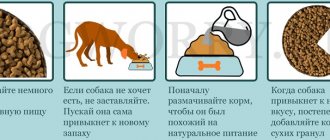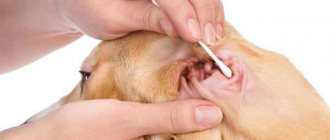How to recognize blood in dog vomit
Nausea is a natural reaction of the body to an irritant. With a single eruption of yellowish vomit with partially digested pieces of food and a sour smell, there is no cause for concern. A different situation arises when blood appears. It is easily recognized by clots, streaks or inclusions that come out along with vomit. Their color varies from bright red to dark brown and even black.
If bloody impurities are detected, record their consistency and shade. This will help your veterinarian understand why your dog is vomiting blood. For a more accurate diagnosis, a sample of vomit will be useful. Place it in a clean container and take it with you to your appointment.
Symptoms
Vomiting and diarrhea are just symptoms of the underlying disease. By their nature, one can determine an approximate range of pathologies.
What can vomiting tell you? Vomiting once is not dangerous. The dog regurgitates excess food, eaten grass, and mucus on an empty stomach. Such a single attack can happen due to stress.
- If a dog vomits the food he has eaten, then one can suspect: poisoning, injury, heat stroke, a reaction to stress, a foreign body in the stomach.
- A single vomiting of white foam is not a pathology. Repeated requires a medical examination.
- Bile in vomit is observed during ulcers, gastritis, and prolonged fasting.
- The presence of fresh blood indicates damage to the esophagus, pharynx, oral cavity, and impaired hemostasis.
- Blood during gastric bleeding reacts with hydrochloric acid and becomes brown, even black. The vomit looks like coffee grounds.
Diarrhea can be acute or chronic. If a dog has bloody diarrhea, this is always an alarming sign. Normally, dog feces are homogeneous, well-formed, without inclusions, the color depends on the food (from brown to dark brown).
With diarrhea and vomiting, the dog loses a lot of fluid. Signs of dehydration: sunken eyes, loss of skin elasticity, weight loss. In this condition, the animal will need intravenous infusion of water-salt solutions.
Infectious diseases are characterized by the presence of mucus streaked with blood in the stool. Fresh blood indicates damage to the rectum and anus.
Typology of hematemesis
The causes of hematemesis depend on the appearance of the vomit. Read it carefully before going to the veterinary clinic.
Bright red hue of blood
A bright red tint is characteristic of uncoagulated blood that has not been exposed to gastric juice. This symptom occurs when there is mechanical damage to the oral cavity, pharynx or esophagus by a stuck object. Due to the discomfort that occurs, copious amounts of saliva are produced.
Dark clots
The appearance of dark clots indicates deeper damage. When internal bleeding occurs, a chemical reaction occurs with gastric juice, changing the color from bright red to brown. A sick dog is vomiting dark clots of coagulated blood.
With foam
The presence of foam is the result of another reaction. The reason for its appearance depends on the color. A bright red hue appears when the lung is damaged. Fresh blood turns into foam when mixed with air. The dark foam results from a reaction with the mucus that protects the stomach wall from acid.
With bile
Vomiting with bile is a characteristic symptom of damage to the gallbladder, liver, small intestine and pancreas. It is easily identified by its dark brown or dark green color, sharp and sour smell. This condition is accompanied by heavy bleeding due to a clotting disorder.
Associated disorders
Depending on the cause, bloody vomiting in a dog is accompanied by a variety of associated disorders. These include
:
- diarrhea, discoloration of feces to black and the appearance of bloody spots;
- yellowing of mucous membranes and unusually bright shade of urine;
- frequent licking and refusal of water;
- increased excitability against the background of severe lethargy;
- decreased appetite and sudden weight loss;
- difficulty breathing and rapid pulse;
- temperature increase;
- dullness and hair loss;
- profuse drooling, belching, rumbling and abdominal pain;
- putrid or acetone smell from the mouth.
If you notice any of the above symptoms, take your dog to the vet. The earlier the diagnosis is made, the greater the chance of successful treatment without complications.
Diagnosis of possible diseases
The appearance of hematesis in a dog is a reason to immediately seek help from a veterinarian. In a hospital hospital setting, it is possible to determine the exact cause of the development of the pathological condition.
Instrumental and laboratory research techniques are used. A general clinical examination necessarily includes measurement of body temperature, pulse rate and respiratory movements. By conducting a palpation examination, the veterinarian determines the presence of stagnation in the intestinal tract. It is also possible to determine the thickness of thin sections, changes in the size of the liver, or dropsy of the abdominal cavity. Laboratory diagnostic methods are:
- general clinical and biochemical blood test;
- serological examination and general urine analysis.
Establishing an accurate diagnosis includes mandatory ultrasound diagnostics. The walls of the intestinal tract are visualized. It is necessary to use endoscopy, with parallel sampling of tissue structures of the mucous membrane lining the digestive tract.
Probable causes of hematemesis
A possible cause can be suggested by the appearance of the vomiting and accompanying symptoms. The most common ones include
:
- Gastrointestinal infections
(enteritis, leptospirosis, hepatitis). When infected with viruses or other pathogenic microorganisms, fever and severe weakness are observed. Parvovirus enteritis, accompanied by acute diarrhea, is especially dangerous for puppies. If severe dehydration occurs, a small pet may die.
- Ulcerative
formations
. Thinning of the walls of the gastrointestinal tract, caused by poor diet or frequent infections, is fraught with the formation of bleeding ulcers. The disease is accompanied by alternating diarrhea and constipation. Bloody clots appear in the stool and vomit. - Oncological
diseases
. Bloody vomiting with cancerous tumors appears in the later stages. It is important to seek help as quickly as possible to prevent the development of metastases.
Internal organ
injuries caused by a foreign object entering the throat, stomach or intestines. Damage to the larynx is accompanied by wheezing and coughing, and injuries to the stomach are accompanied by acute pain.- Poisoning
by poisons
. Intoxication is accompanied by vivid and rapidly developing symptoms. The animal requires urgent hospitalization. - Acute
helminthiases
. If the dog has vomited adult parasites, larvae or eggs, then the cause of hematemesis is obvious. Worms can also be passed out in the feces. When intoxicated by helminth waste products, stool disturbances, abdominal pain, weakness and dulling of the coat are noted. In particularly severe cases, intestinal obstruction occurs. - Kidney
failure
. This condition is accompanied by an ammonia smell from the mouth.
The risk group includes animals with chronic diseases and pets taking non-steroidal anti-inflammatory drugs (Ibuprofen, Diclofenac). These medications reduce the number of platelets, which are responsible for the elasticity of blood vessels. As a result of thinning of the vascular walls, bleeding occurs.
Why is my dog vomiting blood?
Vomiting is a violent expulsion of the contents of the stomach and upper small intestine. It may contain food, liquid, or debris that the dog has swallowed.
This condition is preceded by other signs:
- nausea;
- excessive drooling;
- gagging;
- strong contractions of the abdominal muscles and diaphragm.
Short-term vomiting is not associated with any disturbances in the functioning of the body. This is a natural process for a predator to cleanse the stomach of swallowed bones, fur, and indigestible fragments.
If a puppy or adult dog vomits, then this disorder occurs:
- due to a disease of the digestive system;
- renal or liver failure;
- pancreatitis;
- nervous system disorders;
- taking irritants or poisons.
Bloody vomiting appears as a consequence of three basic reasons:
- disorders of the esophagus;
- irritation of the intestines or stomach, which leads to inflammation, internal bleeding - as a result, the dog vomits blood, trying to remove it from the stomach;
- ingestion of a foreign object - a foreign body can cause inflammation or injury to the mouth, esophagus, lungs, stomach and other organs.
Vomiting with white foam accompanies several ailments and conditions:
- eating toxins, poisons, foreign objects;
- “bilious vomiting syndrome”;
- intestinal obstruction;
- kennel cough;
- pancreatitis.
Did you know? For some people, vomiting is caused by feelings of panic and fear. This phenomenon is called emetophobia.
If an animal vomits with streaks or clots of mucus, then this is the most explainable condition. Mucus covers the intestinal walls with a thick layer. It protects them from damage by gastric juice and at the same time organizes the movement of food through the esophagus, acting as a lubricant. If the walls become inflamed, the body produces more mucus to seal the damage. That's why owners observe these impurities in their pet's vomit.
Depending on the underlying cause, vomiting will occur due to disturbances in different physiological systems.
Among them there are 2 main groups:
- organs responsible for digestion;
- organs that transport food to the stomach.
When treating GI problems, the veterinarian's goal is to first identify the part of the system where the problem is located, and then determine the specific cause and determine the appropriate treatment.
Note that vomiting is different from regurgitation. The latter is a passive movement of the stomach contents, which is not accompanied by muscle contraction. This condition is colloquially referred to as “dog burping.” Coughing or difficulty breathing are more likely symptoms of regurgitation than vomiting, since belching causes air to be expelled from the esophagus.
Find out why your dog vomits bile and what to do about it.
Gastrointestinal Trauma
The term “trauma” means a violation of the integrity of an organ.
This could be damage:
- esophagus;
- stomach;
- liver;
- pancreas;
- intestines;
- rectum.
Bones are the most common cause of injury. When the dog chews, they break into small pieces. Many of them will be crushed by gastric juices. Sometimes these sharp fragments injure the esophagus, stomach or intestines.
This can cause a range of illnesses, including peritonitis. It occurs when bacteria enter a wound. In most cases, peritonitis is life-threatening. It is also accompanied by prolonged vomiting with foam.
If a pet has swallowed a toy or other object, then a single attack is an attempt to get rid of what it has swallowed. The appearance of a small amount of blood is evidence that damage to the wall of the small intestine has occurred in the path of this object.
The same thing happens if a dog tries to get rid of a bone that is stuck in the throat or esophagus. Sometimes surgery may be necessary to resolve the problem.
Important! Therapeutic fasting after an attack of vomiting should last at least 6
–
8 ocloc'k. During this time, the stomach will recover a little. This is how long it takes for food to move through your pet’s esophagus.
Infections
Sometimes pathogenic microorganisms enter the digestive system. This happens under conditions of stress and decreased immunity. Diagnosis of a specific infectious disease depends on the detection and identification of the microorganism that caused it.
Some infectious diseases of dogs:
| Name of the disease | Main symptoms |
| Campylobacteriosis | The causative agent is bacteria of the genera Campylobacter and Arcobacter. The typical symptom is mucous, watery, or bilious diarrhea (with or without blood). |
| Salmonellosis | Salmonella infection can cause serious blood poisoning (sepsis) or intestinal inflammation. |
| Parvovirus infection | This is one of the most dangerous diseases for dogs, manifested by vomiting blood. |
| Kennel cough | This is an upper respiratory tract infection. Accompanied by cough, nasal discharge, runny nose and vomiting with pink foam. |
Other signs of a bacterial infection include:
- loss of appetite;
- fatigue;
- joint pain;
- bloody diarrhea;
- fever;
- bloody vomiting.
A veterinarian must diagnose a bacterial infection in order to prescribe appropriate treatment.
Did you know? About 10% of all visits to the veterinarian are due to gastrointestinal disorders.
Poisoning
Symptoms of poisoning include gastrointestinal and neurological problems, heart and respiratory problems.
In most cases they are accompanied by bloody vomiting. A pet can be poisoned by various substances, for example:
- over-the-counter medications (including Acetaminophen, Ibuprofen, and Naproxen), as well as herbal and nutraceutical products;
- prescription drugs for humans, the most common of which are anti-inflammatory and pain relievers that cause stomach and intestinal ulcers or kidney failure; antidepressants can interfere with heart function;
- cakes, chips, alcohol, coffee and other food from your table;
- household chemicals;
- poisons for rodents.
Food intolerance
The terms food allergy and food intolerance are used to describe any adverse food reactions in dogs. Actually, "food allergy" would be a clearer explanation.
This means that in response to a certain substance entering the body, the immune system begins to destroy it, which causes:
- cough;
- sneezing;
- itching;
- tearfulness;
- skin rashes;
- skin inflammation.
Did you know? In the time of Leonardo da Vinci, it was believed that the stomach is involved in breathing, as it moves at the moment of inhalation. This is not entirely true, but this idea helped scientists discover the role of muscles and the diaphragm in breathing and the functioning of the gastrointestinal tract.
If the food allergy is severe enough, it is accompanied by vomiting blood. Her additional symptoms are bloody stools and severe abdominal pain. Without an accurate determination of current allergens, it is impossible to correctly prescribe treatment.
Cancerous tumors
According to statistics, intestinal tumors are found in 10% of dogs. Most of them are malignant, but there are exceptions. The main ones among them are polyps that form in the rectum. Older dogs, especially males, are predisposed to such tumors.
Clinical signs of intestinal neoplasms include:
- weight loss;
- diarrhea;
- vomiting;
- anorexia;
- less often - melena (resinous feces);
- hypoglycemia (low blood glucose levels).
Symptoms vary depending on the location of the tumor. If the neoplasms become very large in size, then vomiting will certainly be present.
Stomach ulcer
Vomiting is one of the symptoms of a stomach ulcer.
Digestive system diseases can be caused by:
- lack of enzymes;
- damage to the digestive tract, such as stomach ulcers or chronic inflammation;
- birth defects.
The ulcer is accompanied by vomit that looks like coffee grounds.
The disease occurs due to damage to the gastric mucosa by sharp objects, eating very hot food, or swallowing large pieces. Did you know? Sperm whale vomit is very expensive. They are used in the perfume industry.
Other reasons
Bloody inclusions can be observed if the dog vomits on an empty stomach. This phenomenon is known as “bilious vomiting syndrome.” If a dog has not eaten for several hours, bile accumulates in the digestive system. It irritates the intestinal mucosa and the small blood vessels that are located there. As a result, early in the morning or late in the evening, you observe yellow-green vomit, which sometimes contains bloody spots.
Bloody vomiting occurs as a result of eating inedible objects. Even socks, tennis balls and other things cause the problem. The thing is that a dog has much fewer taste buds than a human. And what seems inedible to people is quite attractive to our four-legged friends.
Chronic gastroenteritis, or long-term inflammation of the stomach, is another potential cause. Bleeding occurs as a result of periodic vomiting and inflammation of the mucous membrane.
Important! Very rapid swallowing of food or inflammation in the oral cavity (stomatitis) can cause inflammation in the esophagus.
Many gastrointestinal diseases are not associated with infectious organisms. Their reasons include:
- binge eating;
- consumption of low-quality or indigestible food (bones, wool), chemicals;
- blockage caused by swallowing foreign objects.
The presence of parasites also often causes digestive tract disorders in animals. They affect the intestinal walls when they attach to them and begin to feed. The vital activity of internal parasites causes poisoning of the body and can cause vomiting. Since the signs of worm infection are similar to those observed with other diseases, the diagnosis is made by a veterinarian by examining the animal’s urine, feces and blood.
Reatitis often causes dogs to vomit white foam. This is a condition of inflammation and swelling of the pancreas. If food cannot be properly crushed and removed from the body, then the animal cleanses the intestines of it through vomiting.
Helping your pet before seeing a veterinarian
Do not use antiemetic drugs. Vomiting removes toxins, so interrupting it will negatively affect the general condition of the patient.
To avoid infection, avoid contact with other pets. Stop feeding to reduce stress on your stomach. Drinking too much can cause more vomiting, so offer your dog an ice cube.
Be sure to call your veterinarian for advice on first aid medications. Self-selecting medications can be fatal. If it is impossible to urgently visit a veterinarian, it is recommended to give 1 tablet of Kvamatel. This drug reduces the amount of hydrochloric acid and reduces stress on the stomach.
In case of poisoning, only 2 hours are allotted for emergency assistance. If you don’t have time to get to the clinic, then proceed according to the following scheme:
- Introduce 3 percent hydrogen peroxide inside. The dosage is determined by weight: 1.5 ml per 1 kg.
- Give an activated carbon tablet. Repeat this procedure every 4 hours.
- Inject vitamin K1 (Phytomenadione) subcutaneously, an antidote for rat poison. For the first time, there should be 5 mg per 1 kg of weight, and after 12 hours – 1 mg.
Do not use folk remedies and take your dog to the vet as soon as possible. Remember that first aid for poisoning is not treatment. Only a doctor can save the animal.
Diagnosis, treatment and prevention
Do not hesitate to contact the clinic. In case of damage to internal organs and poisoning by poisons, the clock counts.
Making a diagnosis in a veterinary clinic
To make a diagnosis, you will have to donate blood, urine and feces. Internal damage, foreign bodies and formations will be determined using x-rays and ultrasound. If an ulcer is suspected, an endoscopic examination cannot be avoided.
Surgery is suggested when a foreign object is detected or serious organ damage is detected. In other cases, taking medication is sufficient.
Drug therapy
Until vomiting is eliminated, the dog is placed in a hospital. Nutrients are administered through an IV; in severe cases, blood transfusion (blood transfusion) is recommended.
Drug therapy involves the use of antibiotics, anti-inflammatory drugs, antispasmodics, sorbents, antiemetics, anthelmintics and immunomodulators. In case of poisoning, the dog's stomach is washed and an antidote is administered.
To eliminate the ulcer, injections of pure medical alcohol are used. It cauterizes damaged mucous membranes and stops bleeding. To restore damaged tissue, a therapeutic diet is prescribed.
Diet and nursing
At the end of the starvation diet, the animal is transferred to a gentle diet. Usual portions are reduced, and the number of meals is increased. To restore the body, it is recommended to consume rice water, oatmeal and low-fat cottage cheese. When dry feeding, medicated feed is used, sometimes the granules are soaked.
Until recovery, the walking time is reduced to 10 minutes. Intense loads are excluded. If the dog lives in an outdoor enclosure, prepare a soft and warm place in the house and take him away.
Do not stop taking your medications once you feel better. Follow your doctor's advice and seek help if any alarming symptoms occur.
Prevention
To prevent the health problems described above in your pet, you should follow the recommendations for feeding and drinking, and also do not forget about physical activity:
- the diet should be balanced, and the portion size should correspond to the size of your four-legged friend;
- It is advisable to feed the dog every day at approximately the same time and avoid starvation;
- fresh water should always be freely available;
- the dog must have all the necessary vaccinations according to age, his life really depends on it;
- every three months it is necessary to treat your pet for fleas and parasites;
- After each walk, inspect for ticks;
- It is better not to walk your dog in direct sunlight.











